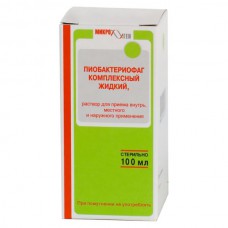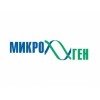Expiration date: 12/2026
Synonyms: Pyophage
Dosage form
Solution for oral, topical and external use
Composition
1 ml of the drug contains:
Active substance:
Sterile purified filtrates of bacteria phagolysates Staphylococcus, Enterococcus, Streptococcus, enteropathogenic Escherichia coli, Proteus vulgaris, Proteus mirabilis (with Appelman activity - not less than 10-5), Pseudomonas aeruginosa, Klebsiella pneumoniae, Klebsiella oxytoca (with Appelman activity - not less than 10-5). less than 10-4) - up to 1 ml.
Auxiliary substance:
preservative-8-hydroxyquinoline sulfate-0,0001 g / ml (calculated content);
or 8 - hydroxyquinoline sulfate monohydrate in terms of 8-hydroxyquinoline sulfate-0.0001 g / ml (calculated content).
Description of dosage form
Transparent liquid of yellow colour of varying intensity, and a possible greenish tint.
Pharmacological action
The drug causes a specific lysis of bacteria Staphylococcus, Enterococcus, Streptococcus, enteropathogenic Escherichia coli, Proteus vulgaris, Proteus mirabilis, Pseudomonas aeruginosa, Klebsiella pneumoniae, Klebsiella oxytoca.
Indications
Treatment and prevention of pyoinflammatory and intestinal diseases caused by staphylococci, enterococci, streptococci, Pseudomonas aeruginosa, Klebsiella, pathogenic E. coli of various serogroups, Protea in internal, rectal and external use.
- diseases of the ear, throat, nose, Airways and lungs-inflammation of the sinuses of the nose, middle ear, sore throat, pharyngitis, laryngitis, tracheitis, bronchitis, pneumonia, pleurisy;
- surgical infection - festering wounds, burns, abscess, phlegmon, furuncles, carbuncles, gidradenit, panaritiums, paraproctitis, mastitis, bursitis, osteomyelitis;
- urogenital infections-urethritis, cystitis, pyelonephritis, colpitis, endometritis, salpingooforit;
- posttraumatic conjunctivitis, keratoconjunctivitis, purulent corneal ulcers and iridocyclitis;
- enteral infections-gastroenterocolitis, cholecystitis, dysbacteriosis;
- generalized septic diseases;
- pyo-inflammatory diseases of newborns-omphalitis, pyoderma, conjunctivitis, gastroenterocolitis, sepsis, etc.;
- other diseases caused by bacteria Staphylococcus, Streptococcus, Enterococcus, Proteus, Klebsiella pneumonia and oxytocic, Pseudomonas aeruginosa and E. coli.
For prophylactic purposes, the drug is used for the treatment of surgical and newly infected wounds, as well as for the prevention of nosocomial infections according to epidemic indications.
Contraindications
Hypersensitivity to the components of the drug.
Application for pregnancy and breastfeeding
It is advisable to use the drug during pregnancy and breastfeeding.
Method of application and doses
Treatment of pyoinflammatory diseases with localized lesions should be carried out simultaneously both locally and through the mouth, 7-20 days (according to clinical indications).
Depending on the nature of the focus of infection bacteriophage used:
1. Topically in the form of irrigation, tools and plugging of liquid phage in an amount up to 200 ml depending on the size of the affected area. In abscesses bacteriophage is injected into the cavity of the hearth after removal of pus by puncture. The amount of the injected drug should be slightly less than the amount of remote pus. In osteomyelitis, bacteriophage of 10-20 ml is poured into the wound after appropriate surgical treatment.
2. Introduction to the cavity-pleural, articular and other limited cavity to 100 ml bacteriophage, and then leave capillary drainage, through which for several days re-enter bacteriophage.
3. When cystitis, pyelonephritis, urethritis drug is taken orally. If the cavity of the bladder or renal pelvis is drained, bacteriophage is injected through the cystostomy or nephrostomy 1-2 times a day, 20-50 ml into the bladder and 5-7 ml into the renal pelvis.
4. In purulent-inflammatory gynecological diseases, the drug is injected into the cavity of the vagina, uterus at a dose of 5-10 ml daily once.
5. In purulent inflammatory diseases of the ear, throat, nose, the drug is administered at a dose of 2-10 ml 1-3 times a day. Bacteriophage is used for rinsing, washing, instillation, introduction of moistened turund (leaving them for 1 hour).
6. In conjunctivitis and keratoconjunctivitis, the drug is instilled 2-3 drops 4-5 times a day, with purulent corneal ulcer - 4-5 drops, with purulent iridocyclitis, the drug is used 6-8 drops every 3 hours in combination with ingestion.
7. In the treatment of stomatitis and chronic generalized periodontitis the drug is used as a rinse mouth 3-4 times daily at a dose of 10-20 ml, as well as the introduction in periodontal pockets turundae, soaked with myobacterium for 5-10 minutes.
8. In intestinal forms of the disease, diseases of internal organs, dysbacteriosis bacteriophage is used through the mouth and enema. Through the mouth bacteriophage give 3 times a day on an empty stomach 1 hour before meals. In the form of enema is prescribed 1 time a day instead of one reception through the mouth.
The recommended dosage of the drug
| Age | Dose on 1 reception (in ml) | |
| through the mouth | enema | |
| 0-6 month | 5 | 10 |
| 6-12 month | 10 | 20 |
| from 1 year to 3 years | 15 | 30 |
| from 3 years to 8 years | 20 | 40 |
| 8 years and older | 30 | 50 |
The use of bacteriophages does not exclude the use of other antibacterial drugs. If before application of bacteriophage chemical antiseptics were applied to treatment of wounds, wound should be thoroughly washed with sterile 0,9% solution of sodium chloride.
The use of bacteriophage in children (up to 6 months).
When sepsis, enterocolitis of newborns, including premature babies, bacteriophage is used in the form of high enema (through a gas outlet tube or catheter) 2-3 times a day (see table.). In the absence of vomiting and regurgitation, it is possible to use the drug through the mouth. In this case, it is mixed with breast milk. Possible combination of rectal (enema) and oral (mouth) use of the drug. The course of treatment for 5-15 days. In case of recurrent course of the disease, repeated courses of treatment are possible. In order to prevent sepsis and enterocolitis in intrauterine infection or the risk of nosocomial infection in newborn children bacteriophage is used in the form of enema 2 times a day for 5-7 days.
In the treatment of omphalitis, pyoderma, infected wounds, the drug is used in the form of applications twice daily (gauze cloth moistened with bacteriophage and impose on the umbilical wound or on the affected area of the skin).
Side effect
Is not installed.
Overdose
Is not installed.
Interaction
The use of the drug is possible in combination with other drugs, including antibiotics.
Special instruction
An important condition for effective phagotherapy is the preliminary determination of the sensitivity of the pathogen to bacteriophage and early use of the drug.
It is not suitable for use in vials with impaired integrity or marking, with expired shelf life, with turbidity.
Due to the nutrient content in the preparation, in which bacteria can develop from the environment, causing turbidity of the drug, it is necessary to observe the following rules when opening the bottle:
- wash your hands thoroughly;
- treat cap with alcohol solution;
- remove the cap without opening the tube;
- do not place the stopper on the inside of the table or other objects;
- do not leave the bottle open;
- opened the bottle should be stored in the refrigerator.
Before use a vial should be shaken bacteriophage and viewed. The drug should be transparent.
The opening of the vial and the extraction of the required volume can be performed with a sterile syringe by puncture of the tube. The drug from the opened bottle in compliance with the storage conditions, the above rules and the absence of turbidity, can be used throughout the expiration date.
Influence on the ability to drive vehicles and machinery .
Data are absent.
Form release
Solution for oral, local and external use in vials of 20 or 100 ml vials and 8 20 ml or 1 vial of 100 ml in cardboard pack with application instructions.
Storage conditions
At a temperature of 2 to 8°C in a dark place and out of reach of children.
Transportation conditions.
At a temperature of 2 to 8°C, transportation at a temperature of 9 to 25°C for no more than 1 month is allowed.
Shelf life
2 years. The drug with expired use is not subject.


